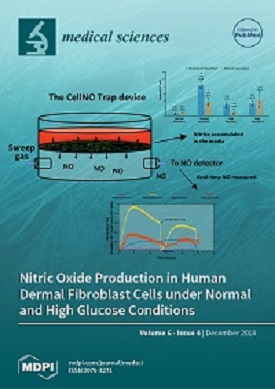Learning How to Heal



Students in CMU’s Doctor of Physical Therapy (DPT) Program are involved in collaborative research on wound healing in patients with diabetes under the supervision of Dr. Caroline Gwaltney. Their research was featured on the cover of Medical Sciences. The article, “Investigative Study on Nitric Oxide Production in Human Dermal Fibroblast Cells under Normal and High Glucose Conditions”, was a collaborative effort with Biomedical Engineering students and faculty in Dr. Megan Frost’s lab at Michigan Technological University (MTU).
Dr. Gwaltney and her DPT students are involved in many research projects with MTU faculty and students, which she describes as “a wonderful collaboration”. CMU’s DPT students worked shoulder-to-shoulder with MTU Biomedical Engineering students in the cell culture lab, where the students focused their studies on the wound healing of diabetic foot ulcers (DFU) and the beneficial properties of nitric oxide (NO) production. Biomedical Engineering faculty and students from MTU designed and validated a device to help measure NO levels. Dr. Gwaltney and her students utilized this technology to better analyze the NO production of both macrophages and fibroblasts, two important cells in the wound healing process.
Wound healing is a complex, cell-mediated symphony of events, progressing through a series of overlapping stages of restoration. Dr. Gwaltney and her students knew from past research that NO production is very important in wound healing, however, complexities arise in patients with diabetes because of their altered NO levels. With a disease like diabetes, the wound healing process becomes disorganized, leading to slow healing wounds, or wounds that do not heal at all. People with uncontrolled diabetes are at a much greater risk of lower extremity (part of the body from the hip to the toes) amputation than those without diabetes due to non-healing DFUs.
Upon further inspection, the research team found reduced NO production to be a major contributor to the impaired healing of DFUs. This study shows that cells grown in normal glucose conditions produced significantly higher levels of NO compared to cells grown in high glucose conditions. Dr. Gwaltney currently has two more students working on wound healing research studying how another important wound-healing cell is produced under the same conditions. Dr. Gwaltney hopes to develop an innovative medical treatment to regulate NO levels in wounds in the future. These advances in diabetic wound healing have the potential to save lives, save limbs, and improve the quality of life for those living with diabetes.
At CMU We Do Research, We Do Real World
Story by ORGS intern Hailey Nelson
May 2021
